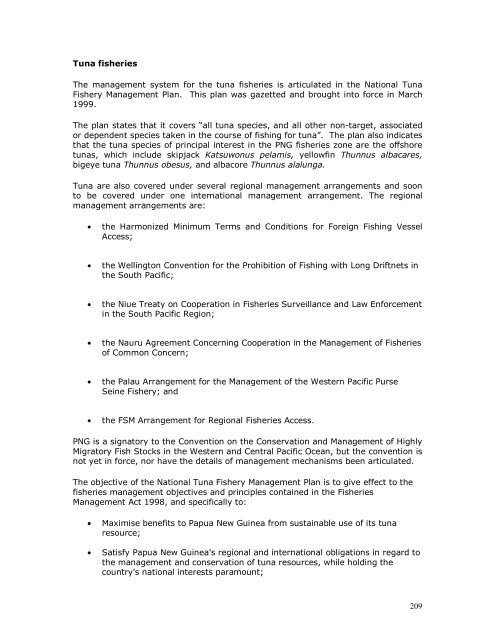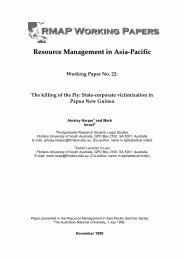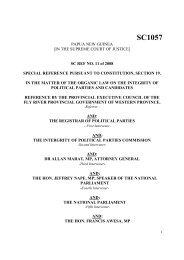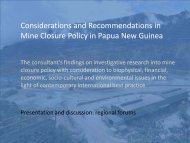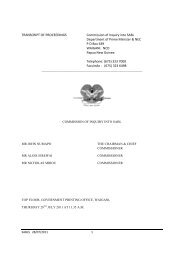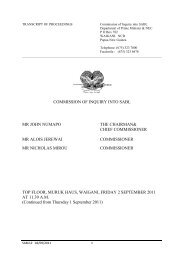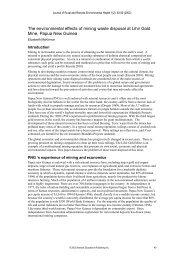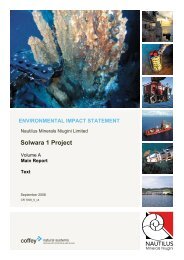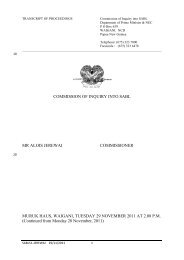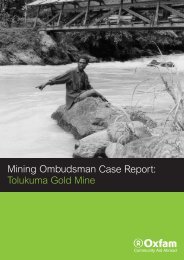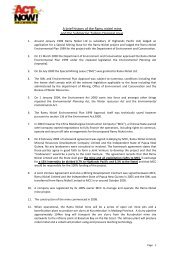- Page 1 and 2:
Fishy BusinessThe social impact of
- Page 3 and 4:
4. Townspeople and market women 158
- Page 6 and 7:
More to the point, the contract for
- Page 8 and 9:
‘development’ projects will be
- Page 10 and 11:
whole concept of MSY; the problem o
- Page 12:
noted most reasonably that the skil
- Page 16 and 17:
• That landowners groups be encou
- Page 18 and 19:
This project adopted an open protoc
- Page 20 and 21:
public figures who had seen RD Tuna
- Page 22 and 23:
suddenly costs the government more
- Page 24 and 25:
problems of the poor.’ He pledges
- Page 26 and 27:
scores of landowner groups who regi
- Page 28 and 29:
areas…There were promises of new
- Page 30 and 31:
might say today. This is certainly
- Page 32 and 33:
During the 1950’s over 860,000 co
- Page 34 and 35:
of reorientation of focus and direc
- Page 36 and 37:
But it is the provincial government
- Page 38 and 39:
title, sensu the Windjammer, is ‘
- Page 40 and 41:
Blue Water Tuna is a private PNG co
- Page 42:
9.5.05: The Bismark Fishing Company
- Page 45 and 46:
The two landowning clans of Parom g
- Page 47 and 48:
ilong mi na long tingting bilong ol
- Page 49 and 50:
ol set ups, say olsem 20 or 30 set
- Page 51 and 52:
No contact or awareness with Marien
- Page 53 and 54:
Los Angeles, CA 90021USATel: 1-800-
- Page 55 and 56:
meters out from its original size,
- Page 57 and 58:
The Offshore Masters is going to be
- Page 59 and 60:
I am not aware of any Environmental
- Page 61 and 62:
“Based on the 970 local labour re
- Page 63 and 64:
Water Resources Act (Chapter No. 20
- Page 65 and 66:
The 26 Local Level Governments in t
- Page 67 and 68:
people were made to believe that ne
- Page 69 and 70:
Nianguma, so the leaders of the 8 c
- Page 71 and 72:
3. That there was a totally unbeara
- Page 73 and 74:
p10:p12:73
- Page 75 and 76:
p.14:75
- Page 77 and 78:
. Marine Ripples articleThe followi
- Page 79 and 80:
In general, I feel SSTC has present
- Page 81 and 82:
•how the tuna factory development
- Page 83 and 84:
Responses to Consent Condition Exce
- Page 85 and 86:
“Sometimes while working we are t
- Page 87 and 88:
fisheries myself at one stage and f
- Page 89 and 90:
N: “Have you sponsored sporting g
- Page 91 and 92:
never cleaned fish before, that was
- Page 93 and 94:
IB: “Oh sure, but somebody’s go
- Page 95 and 96:
Philomena Naura: “The smell aroun
- Page 97 and 98:
There is no covering to the oxidizi
- Page 99 and 100:
Above: four consecutive pay slips f
- Page 101 and 102:
Above is a list of curses said to b
- Page 103 and 104:
duties on one of the ships offloadi
- Page 105 and 106:
on the side of the fishing vessel.
- Page 107 and 108:
The fishery observer told us that i
- Page 109 and 110:
Speaking of prostitution on fishing
- Page 111 and 112:
and if any major disruptions occur
- Page 113 and 114:
Most of us here are very unfortunat
- Page 115 and 116:
The husband of the woman employed a
- Page 117 and 118:
Thomas Nigints was one of the few p
- Page 119 and 120:
Did SST place FADs in the sea?The c
- Page 121 and 122:
doing it, it’s going to be over o
- Page 123 and 124:
Landowners are also deeply disturbe
- Page 125 and 126:
places or settlement where they are
- Page 127 and 128:
in the revenue, so when the opportu
- Page 129 and 130:
And as soon as they’d finished th
- Page 131 and 132:
There is no legal case as yet with
- Page 133 and 134:
owns the land legally and therefore
- Page 135 and 136:
There is still need to recruit more
- Page 137 and 138:
In regard to the production, by the
- Page 139 and 140:
The company invited interested peop
- Page 141 and 142:
strategy is very well used by forei
- Page 143 and 144:
employees and those whose work requ
- Page 145 and 146:
The present Human Resource Manager
- Page 147 and 148:
working gear? In my section I wear
- Page 149 and 150:
working for a whole first week with
- Page 151 and 152:
Serah from Manam island, married wi
- Page 153 and 154:
stret long mipela ol mama husait I
- Page 155 and 156:
The supervisors in the plant/engine
- Page 157 and 158: The color of the sea has changed. F
- Page 159 and 160: Donald Jacob, Catrans fuel distribu
- Page 161 and 162: Kapmandu Service station. Did South
- Page 163 and 164: Three women involved with roadside
- Page 165 and 166: export processing zones and then in
- Page 167 and 168: When we asked if this meant sportin
- Page 169 and 170: then men’s. Usually they’re exc
- Page 171 and 172: The WWF consultant also notes that
- Page 173 and 174: of a company like SST cannot be pla
- Page 175 and 176: East Sepik Governor Arthur Somare s
- Page 177 and 178: The cost of the project is between
- Page 179 and 180: The National Shipping Page, 1.6.04W
- Page 181 and 182: that have similar fish factory set-
- Page 183 and 184: Infofish website : PNG: Tuna export
- Page 185 and 186: Post-Courier 20.6.05185
- Page 187 and 188: Did your application form ask you a
- Page 189 and 190: Do you know whether the Provincial
- Page 191 and 192: The Provincial AdministratorDept. o
- Page 193 and 194: 4. Human Resources registerees, Kew
- Page 195 and 196: 195
- Page 197 and 198: Under Spin-Off Business Activities
- Page 199 and 200: Finally, Honourable Ministers, Memb
- Page 201 and 202: The adverse non-immune (toxic) and
- Page 203 and 204: low income) will have an impact in
- Page 205 and 206: ed and pink plastic roses are every
- Page 207: 207
- Page 211 and 212: • Monitor interactions between th
- Page 213 and 214: Programme is expanding this program
- Page 215 and 216: This office recommends that, since
- Page 217 and 218: commercial industry still deny any
- Page 219 and 220: 219
- Page 221 and 222: 221
- Page 223 and 224: REPORTER: If you come and you put t
- Page 225 and 226: Berman, M. 1997. Faust, the First D
- Page 227 and 228: Lutkehaus, N., C. Kaufman, W.E. Mit


